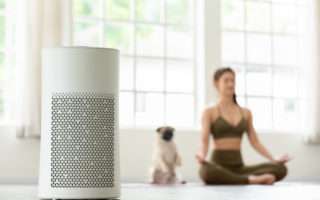
Air purifier in cozy white Living room for filter and cleaning removing dust PM2.5 HEPA at home with woman exercise yoga with dog in background,for fresh air and healthy life,Air Pollution Concept
How do we understand dealing with air pollution in our communities?
Part of it involves collaboration and collective action. There’s also the role of federal and state agencies and groups. These parties are important in terms of monitoring the issue. They’re also involved in talking about clean air solutions.
But there are also individual things you can do at a household level to protect your health. In an era where there are significant contaminants in the air in most American communities, this is important.
Simply speaking, there is a fabric of advocacy in place. There are actionable practices that we can all do to keep our air cleaner over time.
The Clean Air Act
For over half a century, the Clean Air Act has been the broadest federal law in the United States dealing with air quality. It was passed in 1970, and went through various changes over time. It deals with pollutants like ozone and carbon monoxide,. It also covers different types of small particulate matter.
Some of the standards and guidelines in the Clean Air Act have led to better quality of life for Americans. Other benefits include better productivity for workers, and less expense in healthcare. EPA resources show how the Clean Air Act prevented over 200,000 adult mortalities by 2020, also reducing events like ER visits.
Officials are continuing to look at how clean air makes a difference.
Community Air Monitoring
With all of that in mind, community air monitoring is one way we can address air pollution.
An article from last year posted at UC Davis talks about best practices and the role of air monitoring in community efforts to battle air pollution.
“Community air monitoring is a vital practice aimed at safeguarding public health and environmental quality by monitoring air pollutants in residential areas, industrial zones, and urban environments,” writes Camille Elise Hammond of UC Davis. “By continuously measuring air quality, communities can identify potential health risks, assess the impact of industrial activities, and implement strategies to improve air quality. Advanced monitoring technologies, and collaborative efforts between stakeholders are key components of effective community air monitoring initiatives.”
Specific pollutants include carbon dioxide, nitrogen oxide and sulfur dioxide. We also have to look out for various volatile organic compounds or VOCs.
This last item on the list actually represents a number of potentially harmful chemicals that are put into many consumer goods and building materials. Common VOCs include formaldehyde, benzene and other nasty stuff that can really impact your health when these items are breathed in.
Community air monitoring helps us to understand what is in the local air. Then we can figure out how to improve the air quality over time.
Monitoring Equipment
It’s important to have the right hardware to do effective community air monitoring. This often means you want a system of sensors and filters. It’s also good to have a sort of dashboard for understanding air quality at a community level. The article points out other aspects of this like stakeholder engagement, good communication, and access to data. Community engagement efforts, like training programs and educational resources, also help.
The above report shows how the Love My Air program in Denver, Colorado was a test case for success in community air monitoring. In this 2019 program, participants installed air quality sensors in schools and neighborhoods. They did this to monitor air pollution and educate students about environmental health. It shows how local municipal efforts might look as we tackle air quality in our communities.
Monitoring Your Air at Home
At a household level, heads of households can also use air monitors to figure out what the indoor air is like inside of a home. Small business leaders can do the same for their business locations.
The first step is to use an air monitor to see what’s in the air around you. Then you can install different kinds of air purifiers that have the best impact on your particular indoor space.
For example, HEPA filters are effective in scrubbing a lot of microbial pollutants out of indoor air.
While a standard HEPA filter traps over 99.97% of particles down to .3 microns, a super HEPA filter traps down to .1 microns, effective at a rate of 99.99%.
There are also UV systems, probiotic systems that release beneficial bacteria into the air, and heat systems that “zap” unhealthy particles.
For some good practical choices, take a look at the Airpura I-700 or the AllerAir AirMedic Pro 6 Vocarb model, for better breathable air at home or at work.
Let US Air Purifiers LLC help you to figure out what air purifier models to buy. Get what you need to protect your health today!